Dealing with fungus gnats in household plants can be a common nuisance, but I’m going to share some simple steps you can take to naturally eliminate fungus gnats—FOR GOOD! From adjusting watering habits to using natural remedies, getting rid of these pesky insects simply takes a bit of diligence and time.
The key to getting rid of fungus gnats is to eliminate the larvae. But it can be tricky to do this naturally. Since the adults only live for a few days, once all the larvae is dead, the infestation will go away pretty quickly.
This is easier said than done though. The adults can fly, jump, or crawl from one plant to the next, so it can be difficult to eradicate them.
So you have to be persistent in treating them, and ensure that you are diligent about keeping your houseplants healthy to prevent recurring outbreaks.
A Bit About Fungus Gnats
Fungus gnats are tiny black bugs that crawl on top of the soil and fly around your houseplants. They are the most common houseplant pest there is, and they can quickly infest your entire collection. Yuck!
Though the look very similar to fruit flies, they are not the same type of bug. You can read all about how to tell the difference between the two here, so you can make a positive ID.
Fungus Can Multiply Quickly!
There are 4 stages to the fungus gnat life cycle. In the right environment, they can multiply very quickly, and their full lifespan can happen in less than a month.
The adults only live for a week or so, but the females can lay hundreds of eggs during their life. So if you don’t take the right steps to eliminate them, their population can explode in a short amount of time.

9 Natural Fungus Gnat Treatments
There’s no need to resort to chemical pesticides, you can easily fight these pests using natural and organic treatment methods. For the quickest results, you should try all of these:
1. Proper Watering
The #1 reason fungus gnats get into your plants is from overwatering. The larvae thrive in wet soil, and they can’t survive when it’s dry.
So, the easiest and most effective method of eliminating them is to make sure you always water your houseplants correctly. The soil should feel dry to the touch, and never be saturated or soggy.
If you struggle with this, I highly recommend getting an inexpensive moisture gauge to make sure you get it right every time.
2. Water From The Bottom
Fungus gnat larvae live in the top 1 inch of the soil, which tends to stay pretty moist when you water plants from the top. So if you have persistent problems, then try watering from the bottom instead.
To do that, simply pour water into the drip tray or cache pot, and allow the plant to soak it up through the drainage holes in the bottom of the container.
Always dump out any remaining water after about 20-30 minutes, and never leave your plant soaking for longer than that.
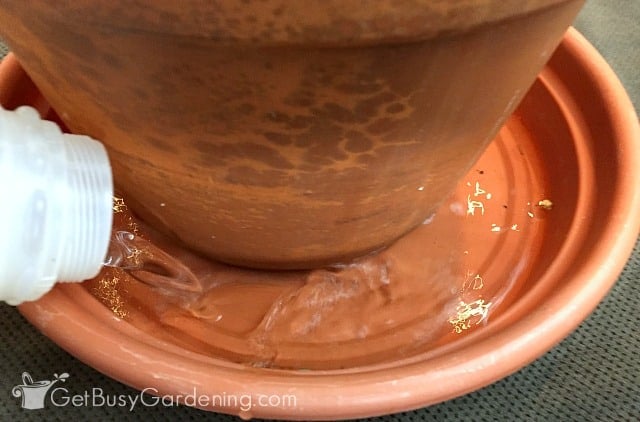
3. Use Gnat Traps
Putting a yellow sticky trap near your indoor plants is a super safe pest control method that will attract and capture the flying adults.
This only works to control the adult population, it will not take care of the problem at the source – the larvae.
But these traps will definitely prevent fungus gnats from flying around to other plants and prevent more larvae from being laid.
Try making your own DIY Fruit Fly Trap!
4. Use Organic Products
There are several organic products that you can pour over the top of the soil to help kill the gnat eggs, larvae, and pupa.
It might take a few applications to see results, and you also have to be careful not to overwater your plants in the process but they are natural. Here are a few of my favorites:
- Insecticidal soap – This will kill any bugs in the soil on contact. You could also make your own by mixing 1 teaspoon mild liquid soap with 1 liter of water.
- Neem oil – This is a natural pesticide that works to kill houseplant pests over time, and it has a residual effect to help keep them away.
- Beneficial nematodes – These are microscopic organisms that will feed on the pupa and larvae, and you can simply add them to your watering can.
- Bacillus thuringiensis israelensis (BTI) – Also known as mosquito dunks or mosquito bits, BTI is a bacteria that’s only toxic to the larvae of bugs like fungus gnats. It takes some time for it to be effective but works.
Related Post: How To Use Neem Oil As Organic Pest Control
5. Remove Gnat Infested Soil Entirely
Remove the top inch of soil and replace it with fresh, sterile, and dry potting mix. This will get rid of most of the fungus gnat eggs, larvae, and pupa, and make it easier for you to gain the upper hand.
Just keep in mind that the eggs could still hatch and mature after you remove it from your houseplant, so make sure you take the infested soil outside to the trash right away.
6. Use Soil Covers
Rather than refreshing the top inch of soil, you can add a dry layer of fine sand, gravel, or crushed granite instead. This will help deter the females from laying eggs. Plus it creates a nice decorative touch.
Or you could try a barrier top dressing, which is a non-toxic product that is specifically made for eradicating fungus gnats.
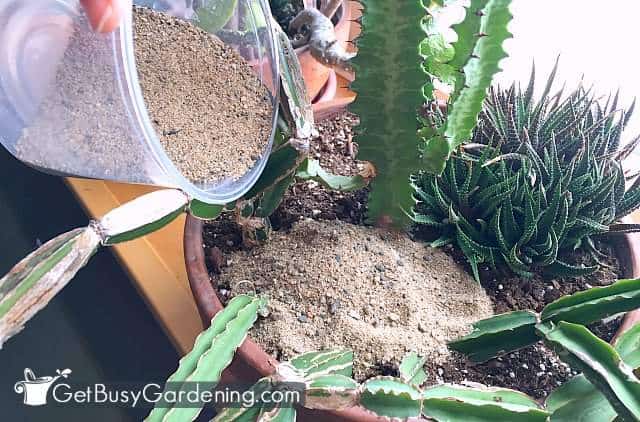
7. Store Unused Soil In A Sealed Container
Bags of potting soil can become a breeding ground for fungus gnats. So it’s important to store any of your unused mediums in sealed containers, especially if you keep them inside the house.
Fungus gnats can’t survive without oxygen, so make sure the container is airtight. I store mine in five gallon buckets with Gamma seal lids on top.
8. Never Reuse Potting Soil
I know it’s tempting to pinch pennies by reusing soil when you repot your indoor plants or after one dies, but you’re just asking for trouble.
Used soil can harbor all sorts of pests and diseases, and can quickly cause an infestation. So it’s always best to use a fresh, sterile mix, and discard the old stuff.
Related Post: 9 Homemade Insecticides & Bug Sprays For Indoor Plants
9. Use Hydrogen Peroxide as Larvacide
Treating the soil with hydrogen peroxide is a natural and effective method. Try mixing 1 part hydrogen peroxide to 4 parts water and use it to wet the top inch. Keep in mind that this will only kill the larvae and pupa, and not the adults that are flying around your plant.
Other Natural Treatments To Try
I have also heard using baking powder, vinegar, coffee grinds, tea tree oil, lavender oil, garlic, parsley, cinnamon can be effective treatments for ridding of fungus gnats.
Where Do Fungus Gnats Come From?
Though indoor plant bugs can come from anywhere, here are the 4 most common ways that fungus gnats could have gotten into your house:
- From the soil of a new pre-infested plant.
- An infested bag of potting mix.
- Other plants that were outside during the summer.
- Through the screen of open windows or doors.
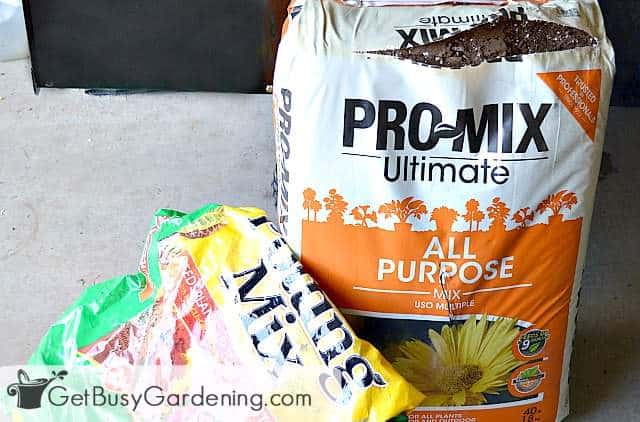
Related Post: How To Get Rid Of Houseplant Bugs Naturally
Common Questions About Fungus Gnats
While it is possible to get rid of fungus gnats, you have to be diligent with your preventative measures to keep them away permanently. The biggest problem is that they can easily come through window screens and doors. So unless you seal your home year round, it’s possible the fungus gnats will return at some point.
The short answer is no, fungus gnats will not kill your houseplants. They are usually just a nuisance and rarely destructive. Sometimes they can cause minor root damage if the infestation is heavy, but normally they only eat rotting plant material.
Everyone with indoor plants will have to fight fungus gnats at some point, it’s just a part of life. Recurring problems are difficult to prevent, and it can be very frustrating. Your best defense is to make sure you don’t overwater, properly store unused potting soil, and always maintain healthy houseplants.
If houseplant pests are driving you crazy, and you want to learn how to get rid of them once and for all, check out my Houseplant Pest Control eBook. It will help you identify common houseplant bugs, and show you exactly how to eradicate them before they kill your beloved plants. Download your copy today!
More About Houseplant Pests
- How To Debug Plants Before Bringing Them Indoors
- How To Get Rid Of Thrips On Indoor Plants
- How To Get Rid Of Spider Mites On Indoor Plants
- How To Get Rid Of Scale Insects On Houseplants
- How To Get Rid Of Whiteflies On Indoor Plants
- How To Get Rid Of Aphids On Houseplants
- How To Get Rid Of Mealybugs On Your Houseplants
Leave a comment below and share your tips for how to get rid of fungus gnats in houseplant soil.


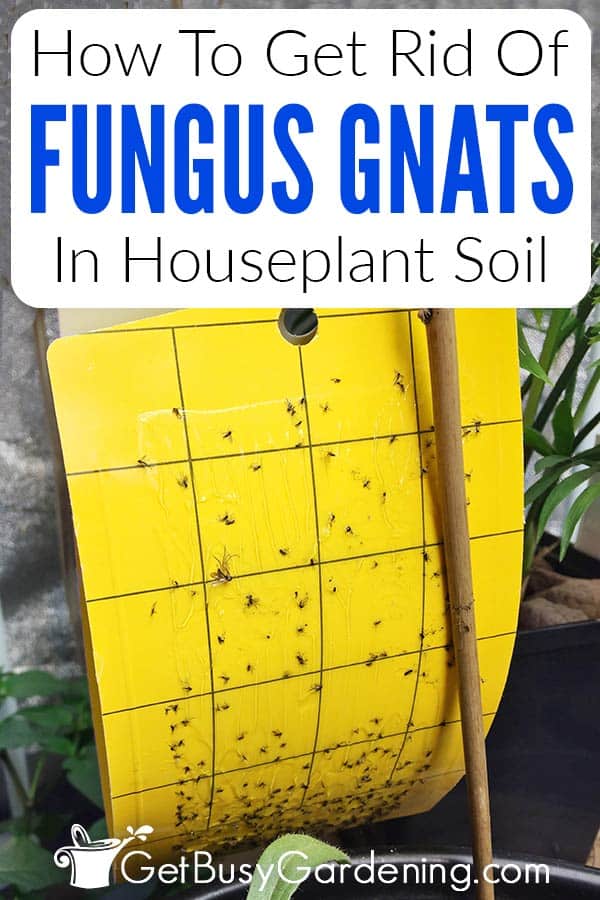

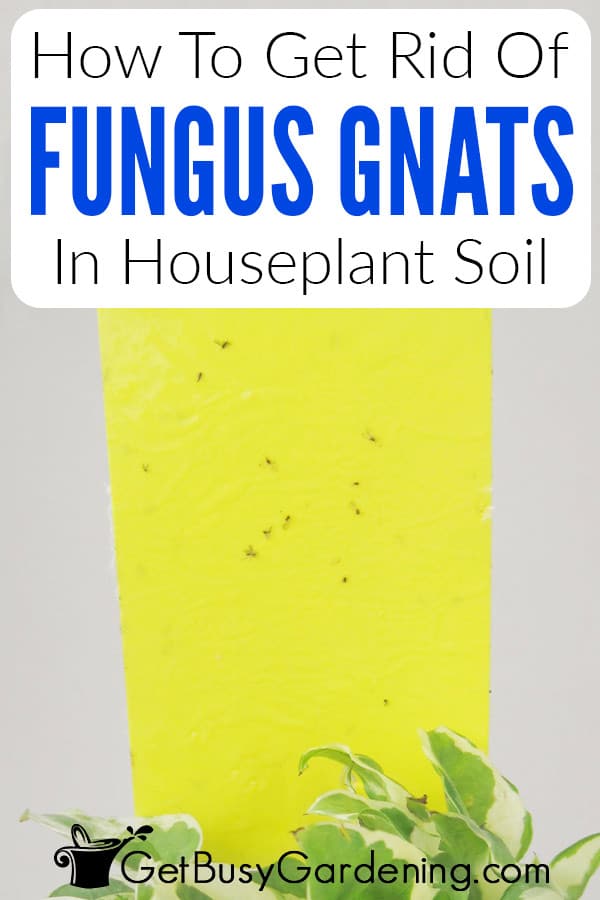
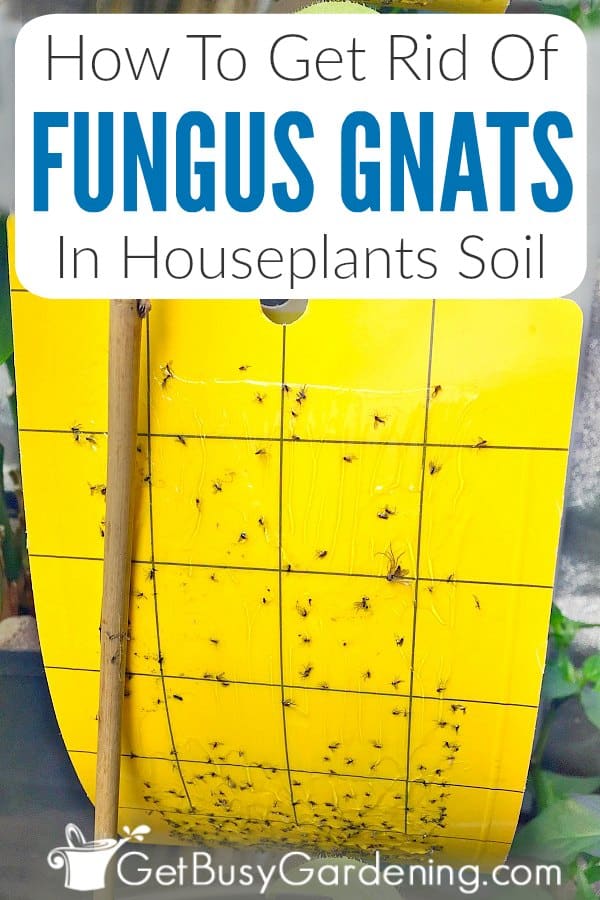
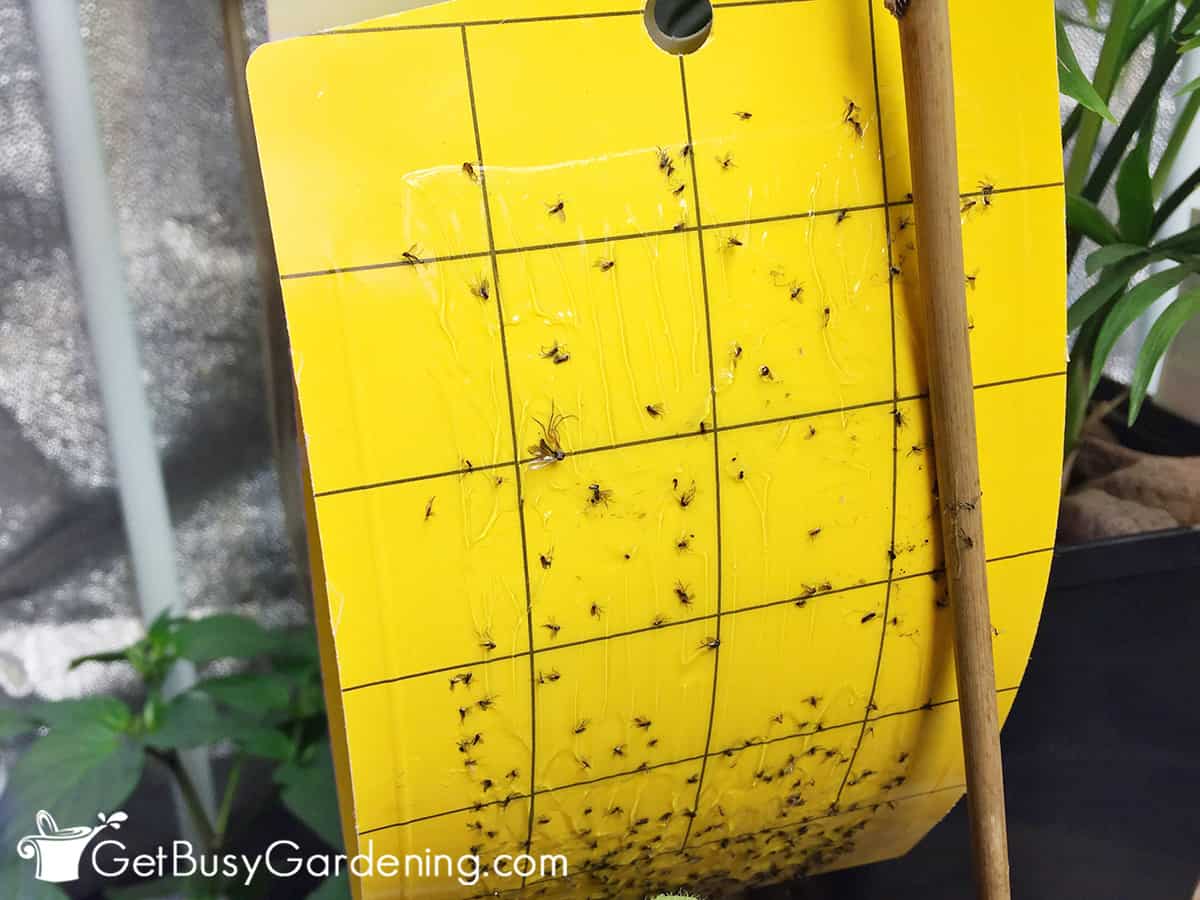


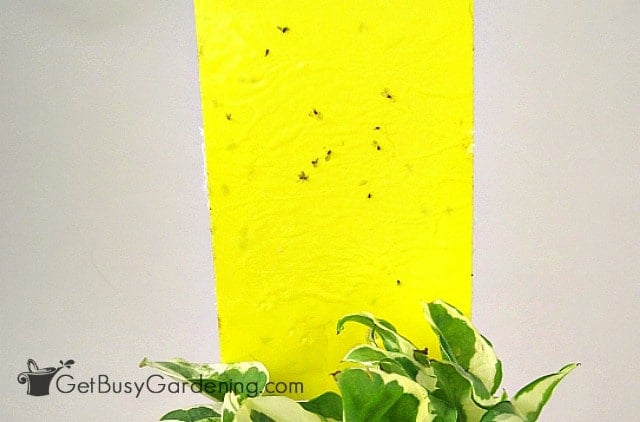
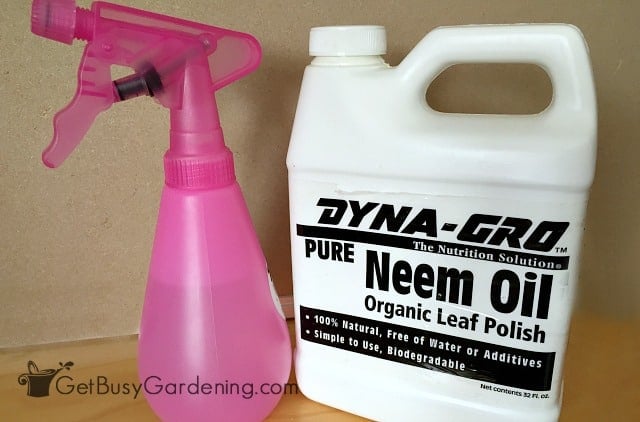
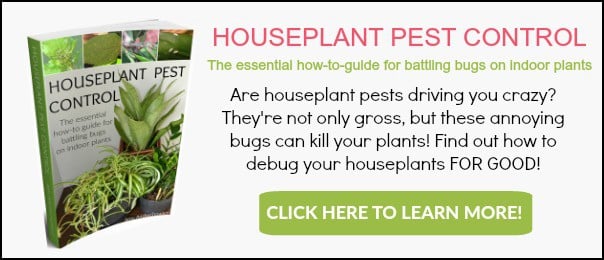

Frank says
Is there any fungicide that one can use to kill the fungus thus cut off the food supply
Amy Andrychowicz says
Good question, but no. Fungus gnats feed on the organic material in the soil, so you can’t kill them by cutting off their food supply, unless you try hydroponics.
Lola A. says
What is the best soil cover or insecticide to use?
Amy Andrychowicz says
I have a whole bunch of products suggestions listed with links in the post above. 🙂
Deb says
I was going to order the soil barrier top dressing that you recommend but it’s no longer available on Amazon. Are there other barriers or if I use sand how thick do I put sand on the soil? I’ve been struggling with these darn things for months, I’ve used neem oil and after a month of that moved on to peroxide then also added cinnamon to the surface of the soil to get rid of the gnats but so far they keep coming back. I’ve gone through many yellow sticky traps and am now ordering larger packages of those. Any help would be appreciated.
Amy Andrychowicz says
Shoot, bummer they’re out of the gnat barrier. Fine sand is another good option, use it to replace the top 1″ of soil. But keep in mind that fungus gnats thrive in moist/wet soil. So the first line of defense is to ensure you’re not overwatering any of your plants. Most indoor plants are fine if you let the top inch or two of soil dry out, and that’s where the gnats live, so doing that alone usually will at least decrease their population by quite a bit. Also, make sure you don’t have any bags of potting soil laying around in your home. If so, you should store those in a sealed container because gnats can live in there too.
Nikki says
Hi can you use rice husks to cover the top of your soil to prevent fungus gnats?
Amy Andrychowicz says
I’ve never tried this myself, so I can’t say for sure. But, as long as it creates a dense layer of protection over the soil, then it could work to keep fungus gnats out.
Nancy says
Would freezing the soil be an appropriate approach ? I was not aware of how to store the soil ( first time using it ) so when I opened the bag there were a lot of maggots or baby gnats I suppose. I sealed that bad boy up and threw it in the freezer!
Amy Andrychowicz says
Yes, freezing the soil works great! I always store it in the garage during the winter, where it freezes solid, and no more fungus gnats!
Angie salgado says
Recently I purchase a fig plant I’m in love with it it’s a perfect healthy plant but noticed little black bugs flying from the plant when I water it or touch the soil I not very good with plants although I love them please can I get some advice Thank you in advance
Amy Andrychowicz says
Yep, those sound like fungus gnats to me. Definitely make sure you’re not overwatering. Figs don’t like a lot of water, the soil should dry 2″ down before you water again. Once you get the moisture level under control and stop overwatering, the gnats will die off, and your plant will be much happier.
Marisue Kamus says
Would cat litter work to cover the top layer of the soil?
Amy Andrychowicz says
Humm… I’m not sure, as I’ve never tried it. The clumping kind might work, but I would think it would end up being a yucky mess, and stinky too, unless you used unscented. I would stick to using one of the soil covers I recommend in the article.
Melinda Teeny says
I think I have fungus gnats on a few houseplants. I find that they are often hovering or hanging out under the pot. Is that consistent? I’ve been trying to address with diamacutous earth but not see that as a solution you propose. Can you speak to that?
Amy Andrychowicz says
Yes, the fungus gnats could be breeding in the soil that’s exposed by the drainage holes, or simply hanging out around the bottoms of the pots because they love the extra moisture that tends to accumulate there. I have never tried DE myself, that’s why I don’t have it listed. I have heard of people using it as a soil cover though, so you could certainly give it a try. It won’t hurt anything.
Clare says
Hi amy,
Fabulous advice – especially around potting mix. On that note, there seem to be gnats in my brand new potting mix – it was recently moved and got a hole in the bag and now has gnats crawling all over it. Do I need to throw it (50lts) or can I tape it up for a week and try to remove the oxygen and moisture?
Amy Andrychowicz says
Oh no! This same thing happened to me several years ago. If you live somewhere cold, then put the bag outside for a few days and let it freeze solid, that will kill the fungus gnats. I recommend always storing your potting soil in a sealed air-tight container, rather than keep it in the bag. Trying to seal the bag will be impossible.
Philippe DEMETS says
Good afternoon Amy, the suggestions you are giving are great, I’m growing worms in theinterior of my house, I have aninfestation of fungus gnats, if I spray a concuction of 3% Hydrogen Peroxide and water on the soil, could it have a negative effect on the present and future of the worms? thanks very much for your advise. Philippe
Amy Andrychowicz says
It sounds to me like you’re saying you have an infestation of fungus gnats in your worm vermicomposting bin/container? I would definitely be careful with how you treat them, because you could end up killing some of your worms in the process. The best way to get rid of them would be to make sure you maintain the proper balance in your bin so the soil is never soggy or really wet. I would recommend you research the best treatment methods that won’t kill your worms. I don’t have any experience with that, sorry.
Alykhan says
I had a winter cactus and Monstera plant that were decimated by gants. I’ve had the winter cactus for over 20 years and sadly it’s been loosing its leaves on a daily basis. I put the yellow sticky paper around them and within a week they were black full of the critters. I’ve sprayed the plant with hydrogen peroxide mix and I will try to remove the top layer of soil. Thanks for posting these tips and I hope I can save my beautiful plants. I will miss the winter bloom this Christmas.
Amy Andrychowicz says
Oh no, sorry to hear your plants are infested with fungus gnats. The gnats themselves don’t usually kill the plants. Infested plants usually die from overwatering, and consistently wet soils is what attracts the gnats. Dropping leaves is also a sign of overwatering. Stick your finger into the soil 2″ deep and see how wet it feels rather than just checking the top layer. Also, ensure your plants are in pots that have drainage holes. Good luck!
Shannon says
Hey there,
I tried the watering from the bottom technique, but then I noticed soil being pulled out of the drainage holes. I still have knats too. Do the mosquito dunks work? I don’t want to kill the beneficial bugs and organisms, which is why I am leery of pesticides. One of my plants is a lemon tree and I have 1 lemon on it. It takes a year to ripen and I don’t want to lose it. That last time I used neem oil, it killed my lemon tree. Please advise.
Amy Andrychowicz says
Have you tried replacing the top inch or so of soil with fresh/dry stuff, or replacing it with a thick layer of fine sand or another similar soil cover? Also, make sure to check all of the other plants in your house. Since fungus gnats can fly, they will just keep reinfesting plant after plant, even if you were able to successfully get rid of them in your lemon tree soil.
Jay says
Are Bounce dryer sheets effective to use by laying them over the top soil to kill the fungus gnat larvae?
Amy Andrychowicz says
I have no idea, I’ve never tried that method before.
Lisa says
I was wondering, when covering the top of the soil (I’ve used potting grit rocks) do you remove the covering at some point or can it stay that way for the long term? And if you remove it, how long would you wait to do so, to be sure the larvae are dead? I have a plant that is finally thriving, but also now has a ton of fungus gnats! So I don’t want to repot or use peroxide if I don’t have to, to not disturb whatever is making the plant so happy in the soil.
Amy Andrychowicz says
You can leave the soil cover on as long as you’d like, there’s no need to remove it.
Rosemary says
Hi Amy, I recently brought my house plants in for the winter. Most of them have fungus gnats, which I am working to get rid of. I have 3 Peace Lilies that I don’t see any fungus gnats on although I am treating them. I believe there are spiders in them because I have found spider webs down in the leaves. The leaves have holes in them and some leaves toward the bottom have died. What can I use to solve this problem?
Amy Andrychowicz says
I would inspect the leaves to see if you can find the bug that is eating them. My guess is that a slug or some other garden bug came in with the plants, because common houseplant bugs don’t eat holes in the leaves. If you can’t find the culprit, then you can treat the leaves with neem oil until all signs of the bugs are gone.
Lee Kelly says
Could you have spider mites? They can kill your plants.
Amy Andrychowicz says
While webbing is a telltale sign of spider mites, they do not eat holes in the leaves. Definitely worth checking for though. 🙂
Genessa says
I have a few cannabis plants are use fabric pots I think that you wrote something about using Or tops for the top of the soil so they suffocate would that work with fabric pots And if so are the roots of my plants will they be able to get oxygen, i’ve been using the yellow sticky tape which does catch a lot of them I’ve also been using neem oil but still there’s so many I’m so desperate I sometimes fantasize of using a flame torch LOL But I wouldn’t do that because I love my plants what do you think the best method is when it comes to using fabric parts and the best way to get rid of these fungus gnats
Amy Andrychowicz says
I’m not sure what “Or tops” are, so I can’t speak to that. However, since fabric pots are very porous, covering the soil would not keep the air from reaching the fungus gnats. The biggest problem is usually overwatering, they love wet soil. So, if you can, allow the top 1″ of soil to dry between waterings. Adding an inch of sand or other fine soil cover on top usually helps with this.
Ann Hunt says
I have been trying to figure out where those little fruitfly like gnats originated from, my husband snd I just started noticing them flying around our heads occasionally. I have cleaned my whole kitchen, plant shelves and more looking for those buggers. Today I looked into the soil of some houseplants and sure enough, a plant I received when my precious grandson died five months ago (he was only 27) it is a schefflara, had tiny black bugs. I have a big clear plastic bag around it until I can get the necessary supplies to get them under control. I hope they haven’t migrated to my other plants, I hope to know more in a day or so, hopefully they will stop “bugging” us. Thank you for your help in recognizing and treating this problem. I was afraid it was becoming something much bigger. It all my years of raising plants this is the first time this has happened!
Amy Andrychowicz says
Oh no, sorry to hear your plant has fungus gnats! Hope you’ll be able to get rid of the quickly.